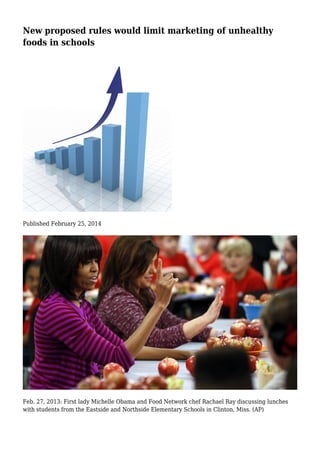
New proposed rules would limit marketing of unhealthy foods in schools
- 1. New proposed rules would limit marketing of unhealthy foods in schools Published February 25, 2014 Feb. 27, 2013: First lady Michelle Obama and Food Network chef Rachael Ray discussing lunches with students from the Eastside and Northside Elementary Schools in Clinton, Miss. (AP)
- 2. WASHINGTON - Even http://www.pc4p.net/?p=27 the scoreboards in high school gyms eventually will have to promote good health. Moving beyond the lunch line, new rules that will be proposed Tuesday by the White House and the Agriculture Department would limit marketing of unhealthy foods in schools. They would phase out the advertising of sugary drinks and junk foods around campuses during the school day and ensure that other promotions in schools were in line with health standards that already apply to school foods. That means a scoreboard at a high school football or basketball game eventually wouldn't be allowed to advertise Coca-Cola, for example, but it could advertise Diet Coke or Dasani water, which is also owned by Coca-Cola Co. Same with the front of a vending machine. Cups, posters and menu boards which promote foods that don't meet the standards would also be phased out. Ninety percent of such marketing in schools is related to beverages, and many soda companies already have started to transition their sales and advertising in schools from sugary sodas and sports drinks to their own healthier products. The proposed rules are part of first lady Michelle Obama's Let's Move initiative to combat child obesity, which is celebrating its fourth anniversary this week. Mrs. Obama and Agriculture Secretary Tom Vilsack will announce the new rules at a White House event. "The idea here is simple -- our classrooms should be healthy places where kids aren't bombarded with ads for junk food," the first lady said in a statement released before the announcement. "Because when parents are working hard to teach their kids healthy habits at home, their work shouldn't be undone by unhealthy messages at school." The rules also would allow more children access to free lunches and ensure that schools have wellness policies in place. The proposed http://www.kfggt.net/?p=25 rules come on the heels of USDA regulations that are now requiring foods in the school lunch line to be healthier. Rules set to go into effect next school year will make other foods around school healthier as well, including in vending machines and separate "a la carte" lines in the lunch room. Calorie, fat, sugar and sodium limits will have to be met on almost every food and beverage sold during the school day at 100,000 schools. Concessions sold at afterschool sports games would be exempt. The healthier food rules have come under fire from conservatives who think the government shouldn't dictate what kids eat -- and from some students who don't like the healthier foods. Aware of the backlash, the USDA is allowing schools to make some of their own decisions on what constitutes marketing and asking for comments on some options. For example, the proposal asks for comments on initiatives like Pizza Hut's "Book It" program, which coordinates with schools to reward kids with pizza for reading. Rules for other school fundraisers, like bake sales and marketing for those events, would be left up to schools or states. Off-campus fundraisers, like an event at a local fast-food outlet that benefits a school, still would be permitted. But posters advertising the fast food may not be allowed in school hallways. An email to
- 3. parents -- with or without the advertising -- would have to suffice. The idea is to market to the parents, not the kids. The rule also makes allowances for major infrastructure costs -- that scoreboard advertising Coca- Cola, for example, wouldn't have to be immediately torn down. But the school would have to get one with a healthier message the next time it was replaced. The beverage industry -- led by Coca-Cola Co., Dr. Pepper Snapple Group and PepsiCo -- is on board with the move. American Beverage Association President and CEO Susan Neely said in a statement that aligning signage with the healthier drinks that will be offered in schools is the "logical next step." "Mrs. Obama's efforts to continue to strengthen school wellness make sense for the well-being of our schoolchildren," Neely said. Although Mrs. Obama lobbied Congress to pass the school nutrition bill in 2010, most of her efforts in recent years have been focused on the private sector, building partnerships with food companies and retailers to sell healthier foods. The child nutrition law also expanded feeding programs for hungry students. The rules being proposed Tuesday would increase that even further by allowing the highest-poverty schools to serve lunch and breakfast to all students for free. According to the USDA and the White House, that initiative would allow 9 million children in 22,000 schools to receive free lunches. The USDA has already tested the program, which is designed to increase participation for students and reduce paperwork and applications for schools, in 11 states. In addition, the Obama administration will announce new guidelines for school wellness policies. Schools have been required to have general wellness policies that set their own general standards for foods, physical activity and other wellness activities since 2004. But the new rules would require parents and others in the school community to be involved in those decisions.